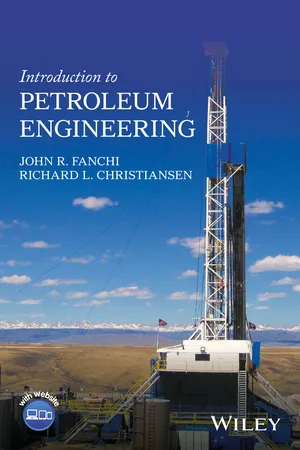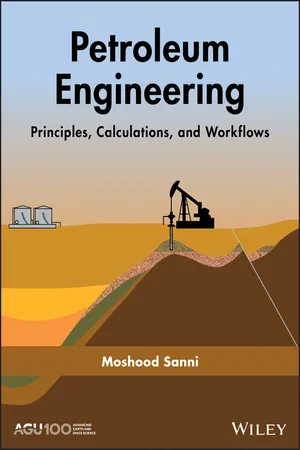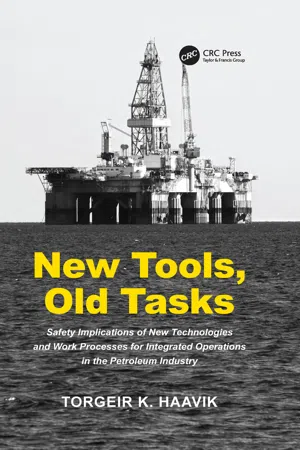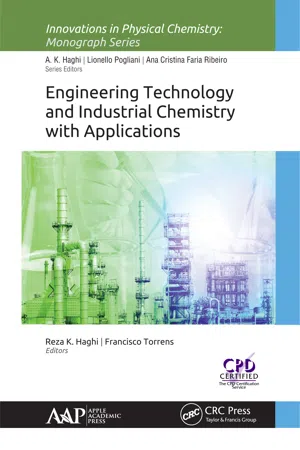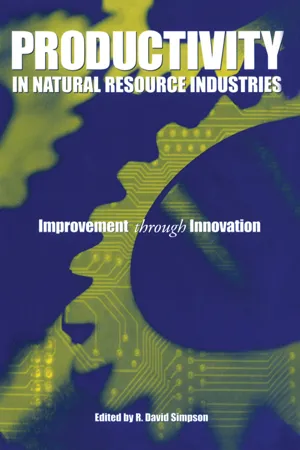Technology & Engineering
Petroleum Engineering
Petroleum engineering involves the exploration, extraction, and production of oil and natural gas. It encompasses the design and implementation of technologies to optimize the recovery of hydrocarbons from underground reservoirs. Petroleum engineers play a crucial role in developing and maintaining sustainable energy resources, as well as in addressing environmental and safety considerations within the industry.
Written by Perlego with AI-assistance
Related key terms
5 Key excerpts on "Petroleum Engineering"
- eBook - ePub
- John R. Fanchi, Richard L. Christiansen(Authors)
- 2016(Publication Date)
- Wiley(Publisher)
1 INTRODUCTION The global economy is based on an infrastructure that depends on the consumption of petroleum (Fanchi and Fanchi, 2016). Petroleum is a mixture of hydrocarbon molecules and inorganic impurities that can exist in the solid, liquid (oil), or gas phase. Our purpose here is to introduce you to the terminology and techniques used in Petroleum Engineering. Petroleum Engineering is concerned with the production of petroleum from subsurface reservoirs. This chapter describes the role of Petroleum Engineering in the production of oil and gas and provides a view of oil and gas production from the perspective of a decision maker. 1.1 WHAT IS Petroleum Engineering? A typical workflow for designing, implementing, and executing a project to produce hydrocarbons must fulfill several functions. The workflow must make it possible to identify project opportunities; generate and evaluate alternatives; select and design the desired alternative; implement the alternative; operate the alternative over the life of the project, including abandonment; and then evaluate the success of the project so lessons can be learned and applied to future projects. People with skills from many disciplines are involved in the workflow. For example, petroleum geologists and geophysicists use technology to provide a description of hydrocarbon‐bearing reservoir rock (Raymond and Leffler, 2006; Hyne, 2012). Petroleum engineers acquire and apply knowledge of the behavior of oil, water, and gas in porous rock to extract hydrocarbons. Some companies form asset management teams composed of people with different backgrounds. The asset management team is assigned primary responsibility for developing and implementing a particular project. Figure 1.1 illustrates a hydrocarbon production system as a collection of subsystems. Oil, gas, and water are contained in the pore space of reservoir rock. The accumulation of hydrocarbons in rock is a reservoir - Moshood Sanni(Author)
- 2018(Publication Date)
- American Geophysical Union(Publisher)
1 Petroleum System and Petroleum EngineeringPetroleum can be used to describe naturally occurring semisolid, liquid, and gas composed of organic compounds. Petroleum types include bitumen, crude oil, and natural gas. The term petroleum can also be used to describe naturally occurring crude oil and its derivatives. In this book, petroleum will mean bitumen, oil, and gas, while derivatives of petroleum will be referred to as petroleum products. The properties of petroleum reservoir fluids are discussed in Chapter 3 .The primary function of a petroleum engineer is to find economical and environmentally acceptable ways of producing petroleum fluids. In order for a petroleum engineer to achieve this objective, the factors affecting the ability of a reservoir to hold fluids, the flow of single and multiphase fluid through the reservoir, the production system at low and high pressure, the reservoir rock and fluid interaction must be well understood. In recent times, environmental considerations have played a crucial role in petroleum exploration and production activities. As such, petroleum engineers are expected to seek technology with minimum environmental damage. Operational activities in the petroleum industry at exploration and production activities are expected to conform to stringent environmental regulations in most parts of the world.1.1. THE PETROLEUM ENGINEER
Petroleum engineers, based on roles and responsibilities, can generally be classified as either reservoir engineers or production engineers.Reservoir engineers have the primary function of optimizing petroleum/hydrocarbon recovery from subsurface reservoirs. The roles of a reservoir engineer vary depending on the life of a reservoir/field, company, division/department within the company, and size of company. Some of the primary functions of a reservoir engineer include, but are not limited to: estimation of hydrocarbons in place; estimating recoverable hydrocarbon; creating hydrocarbon recovery profiles with time; optimization of hydrocarbon recovery; working in a multidisciplinary team to build reservoir models.- eBook - ePub
New Tools, Old Tasks
Safety Implications of New Technologies and Work Processes for Integrated Operations in the Petroleum Industry
- Torgeir K. Haavik(Author)
- 2017(Publication Date)
- CRC Press(Publisher)
Chapter 4Drilling for Oil and Gas 1
1 This chapter is not meant to present petroleum technology and drilling in the fashion of an educational book. It is meant to give a brief introduction to some of the phenomena that characterise drilling operations, with the purpose of providing the reader with useful connotations for the subsequent reading. Some readers may perhaps struggle to see the use of some of the details, but I would urge them not to skip them; one cannot understand IO without understanding the field in which it is introduced. A more thorough elaboration of the topics of this chapter may be found in Hyne (2001).4.1 Two Central Actors – Petroleum Technology and Drilling and Well
Petroleum technology and drilling and well are two central professional communities in oil and gas companies that participate in different phases of a well construction process. The expertise of the two groups will be briefly reviewed here, while the groups’ roles in the well construction process will be elaborated on in Section 4.2 .4.1.1 Petroleum Technology
The petroleum technology department is staffed by geophysicists, geologists, petrophysicists, reservoir engineers and production engineers. The geophysicists are central in interpreting the seismic data, and with the additional use of production data they refine the interpretations of the seismic data and produce cross-sections of the formations with stratification and faults. While the geophysicists are mostly concerned with structures, the geologists are concerned with the geological properties of the rocks, their history of deposition, their drillability, their likelihood of containing petroleum, and the creation or refinement of the geo-model. The petrophysicists are concerned with the reservoir’s rock properties, such as porosity, saturation, permeability and electrical conductivity. These properties are explored by the use of, e.g., different well logs, core samples and seismic measurements. The reservoir engineers are interested in the volumes and composition of hydrocarbons in the reservoir, the flow conditions and the drainage strategies to extract as much hydrocarbons as possible from the reservoir. This also involves advising a well target and an appropriate well path through the reservoir. The production engineers - Reza K. Haghi, Francisco Torrens, Reza K. Haghi, Francisco Torrens(Authors)
- 2018(Publication Date)
- Apple Academic Press(Publisher)
PART IThe Petroleum Industry
Passage contains an image
CHAPTER 1
Petroleum Engineering, Petrochemicals, Environmental and Energy Sustainability: A Vision for the Future
SUKANCHAN PALIT*Department of Chemical Engineering, University of Petroleum and Energy Studies, Bidholi via Premnagar, Dehradun 248007, India 43, Judges Bagan, Haridevpur, Kolkata 700082, IndiaCONTENTS
Abstract1.1 Introduction1.2 The Aim and Objective of this Study1.3 The Need and Rationale Behind this Study1.4 Energy and Environmental Sustainability and the Vision for The Future1.5 The Vision and Status of Petroleum Engineering Science Today1.6 Petrochemicals and Petroleum Refining Today1.7 Crude Petroleum Oil1.8 Recent Advances in Energy and Environmental Sustainability1.9 Recent Research Pursuit in the Field of Petroleum Refining1.10 Recent Technological Vision in the Field of Petrochemicals1.11 Sustainable Development and Petroleum Refining in Today’s World1.12 Opportunities, Challenges, and the Scientific Success Behind Petroleum Refining1.13 Future Research Trends and Future Frontiers1.14 Conclusion, Summary, and Future Perspectives1.15 AcknowledgmentKeywords ReferencesAbstract
Human civilization is witnessing drastic challenges today as regards to energy and environment. Nowadays, energy and environmental sustainability stand in the midst of scientific vision and deep scientific discernment. Petroleum Engineering is ushering in a new era in the field of scientific regeneration and deep scientific rejuvenation. Science and engineering of petroleum refining is in a state of deepening crisis as depletion of fossil fuel resources stands as a truly vexing issue in the scientific horizon. In this chapter, the author pointedly focuses on the immense scientific potential, scientific success and wide horizon in research pursuit in the field of petroleum refining. Petroleum refining is an intensely complex research endeavor. The world of technology and engineering science stands baffled as energy sustainability is in a state of distress with the ever-growing concern of depletion of petroleum resources. The chapter also deeply reviews the area of petrochemicals and energy sustainability with the sole vision of furtherance of science and engineering. Water science is another facet of environmental sustainability today. This treatise with deep and cogent insight relates the scientific success and the scientific profundity in the field of water technology, drinking water treatment, and desalination science. The scientific intricacies, the vast challenges, and the vision for the future are well researched and presented in deep details in this chapter.- eBook - ePub
Productivity in Natural Resource Industries
Improvement through Innovation
- R. David Simpson(Author)
- 2014(Publication Date)
- Routledge(Publisher)
3 Technological Improvement in Petroleum Exploration and Development Douglas R. BohiDOUGLAS R. BOHI is vice president at Charles River Associates, Washington, D.C.E xploration for oil and natural gas has changed a great deal since the days when prospects were identified on the basis of surface oil seeps or topographical formations and when drilling was characterized by a group of roughnecks operating a rotary drilling rig and waiting for a gusher to erupt. Over the past two decades, geologists and geophysicists have developed sophisticated seismic techniques to generate mountains of data that are fed into supercomputers via satellites and used to build complex three-dimensional structural models of the earth. Similarly, drillers now use steerable downhole motors to create wellbores that bend and turn at all angles, as well as sensory systems next to the drill bit to determine its location and angle and the composition of the rock layers as they are encountered. And, where not long ago the search for hydrocarbons was restricted to land areas or shallow water, the technology has been developed to explore in water too deep to use fixed-leg platforms. In this environment, remote drilling systems must be used, production platforms must float, and pressures and temperatures are such that oil and gas flowing through subsea pipelines can turn into paraffin and crystals.Some of the changes in the technology of petroleum exploration and development rival in imagination and expense those involved in exploring outer space. They are a central part of a dramatic story of productivity change that has occurred in the industry in only ten years. This chapter describes the changes in technology and their contribution to lowering costs and boosting productivity in petroleum exploration and development.The term productivity is used in the conventional way to mean the amount of output that can be produced with a given amount of inputs. However, the measures of outputs and inputs used in the context of petroleum exploration and development are not conventional. For example, for the measure of output it is more meaningful to refer to the level of success in finding new discoveries rather than the amount of oil and gas produced. Similarly, the measure of inputs refers to the number of wells drilled or seismic crews at work rather than the more conventional number of labor hours or amount of capital investment. More will be said about the measures of productivity below.
Index pages curate the most relevant extracts from our library of academic textbooks. They’ve been created using an in-house natural language model (NLM), each adding context and meaning to key research topics.
